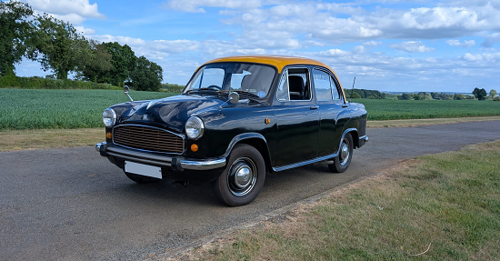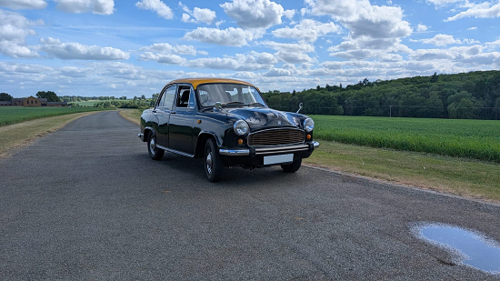“The Ambassador always got through” - Suraj Karavadra and his 1995 Hindustan Ambassador
26 June 2025
For so many of us, there are cars you remember all your life. When Suraj was eight, he flew with his grandfather to India for the summer holiday. As a keen young motoring enthusiast, he asked about the grandparental car and was informed it was “the Rolls-Royce of India – a Hindustan Ambassador!” 26 years later, Suraj acquired one of his own.
Hindustan Motors was established in 1942 in collaboration with Nuffield. Their first vehicle was the Morris Ten-based Landmaster of 1942, and six years later, their cars were manufactured rather than assembled. HM went on to make the Oxford MO-derived Hindustan 14, the Minor—aka the “Baby Hindustan”—and the Oxford Series II-based Landmaster.

In the early 1950s, a Government Tariff Commission recommended “within three years of 1953, the content of indigenous manufacture should be 60 per cent of the value of completely knocked down components”. By 1958 the Government further told India’s three main car makers they would receive licences to import assembly kits of only one type of car each.
As a result, the newly launched Ambassador, Hindustan’s interpretation of Oxford Series III, would dominate a market sector for nearly three decades. HM sold it as “a cut above the rest” and the original versions were powered by the MO’s 1,476 cc side valve engine. By 1960 it gained the 1.5-litre B-series and a Mk, II facelift in Mk.1963. By then, the waiting list was said to be five years.
In 1975, buyers of the latest Mk. III could specify an optional floor gear lever, brake servo assistance, windscreen washers, and separate front seats. By 1979 the
Ambassador Mk. IV gained the frontal appearance it would retain until the end of production. In 1980 there was the option of a BMC diesel engine and in 1982 an Ambassador with this power plant was India’s most expensive car at 102,000 rupees (£6,110).
But by then, a radical change in the nation’s automotive landscape was on the horizon with the advent of the Suzuki-based Maruti 800 in 1983. The Ambassador would remain in production until 2014 as a staple of taxi operators, police forces, and government departments throughout the country. It is said that 16 per cent of Ambassadors were destined for officialdom.

However, Suraj observes that as the 2000s progressed, “You started to see less and less of them. Younger drivers wanted newer designs, and people wanted taxis with air conditioning. In Mumbai, they were last used as cabs around 2010, although some Ambassador taxis are still in use in Calcutta.”
And Suraj never forgot the white, well-used Ambassador that was his grandfather’s car in India. “It was a banger of a car with dented panels - and I fell in love with it. I was fascinated by the curtains in the windows, and the bench front seat”. Suraj still remembers his grandfather’s motto for waiting until the diesel engine was ready to be started - “Count until 120 – not that easy when sat in an Ambassador in the heat of India!”
Suraj also recalls his brother and himself having to push start the mighty car. On one occasion his grandfather produced a large rock from the boot and told him to “put it behind one of the back wheels” as the handbrake was not to be relied on. It was at such moments that Suraj started to doubt if the Ambassador really was the “Rolls-Royce of India”.
These memories remained with Suraj and his wedding car in 2019 was a cream Ambassador hired from Karma Kabs. “My wife and I wanted to pay homage to our respective grandparents, and this was my tribute”. The following year he decided to buy his own Ambassador - “I knew there were a few in the UK” - and joined the 6/80 & MO Oxford & Cowley Club: https://www.facebook.com/groups/1258113167609222/?locale=en_GB. This led to him meeting the Nuffield cars expert Richard Monk. In February of this year, “I gave him a call, and Richard said, “To be honest, I am thinking of selling mine”.
Suraj was on holiday in Egypt at that time - “I leapt off my sun lounger when I heard the news!”. Shortly after returning home, he drove from Wellingborough to Surrey, where, naturally, he could not resist the Monk Ambassador. It ran well and “I really liked the colour scheme. The original paintwork was maroon, but Richard had the Ambassador repainted in Indian taxi livery”. In fact, it played such a role in a Bollywood film shot in the UK.
The Karavadra Ambassador dates from 1995 and is one of a handful of UK-market examples imported by Fullbore Motors. Three years earlier, Autocar noted the price was £5,895, and found “the wind resistance of the body seems to offer more hope of slowing down than the all-drum brakes”. In 2014, Hormazd Sorabjee of Autocar India echoed these observations as he recalled for the BBC:
When I tested the Ambassador for an automobile magazine in the mid-1990s, it was the fastest-accelerating car in India, outpacing the more modern Fiats and Maruti-Suzukis of that age. That it needed the length of an airport runway to stop it was another matter. The maker had barely upgraded the brakes.
Suraj’s Ambassador has the 1.8-litre Isuzu engine, first available in 1992, and separate front seats. “One of my uncles pointed out that in India, the bench front seat meant seeing Ambassadors carrying about ten people.” As for taking to the
road, Suraj wryly observes “It makes my Mercedes-Benz 190 seem modern! The Ambassador seems like a car from 1950s and in fact I recently had to hand signal when the indicators failed”.
Naturally the Ambassador causes quite a stir, Suraj finding “older people first seem to think it is a Morris Oxford, but then they notice the badges and the grille”. Above all, it transports him to when he arrived at family gatherings in his grandfather’s white Hindustan over a quarter of a century ago. “Even when travelling through a monsoon, the Ambassador always got through”.
Of course, you would expect nothing less from the car that was “a cut above the rest”.
With thanks to Suraj Karavadra for his time.
With thanks to Suraj Karavadra for the permission to use the images inthis blog.
